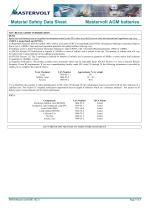
Catalog excerpts

Material Safety Data Sheet I. PRODUCT IDENTIFICATION MANUFACTURER Mastervolt Snijdersbergweg 93 1105AN Amsterdam The Netherlands tel: INT. +31 20 3422100 fax: INT. +31 20 6971006 info@mastervolt.com PRODUCT NAMES Mastervolt LONG LIFE AGM BATTERY, models AGM-55Ah, AGM-70Ah, AGM-90Ah, AGM-130Ah, AGM-160Ah, AGM-225Ah, AGM-270Ah; Mastervolt SLIMLINE AGM BATTERY, models SL-115Ah, SL-150Ah, SL-185Ah, SL-200Ah; Mastervolt AGM 6V BATTERY, models AGM 6V-260Ah, AGM 6V-340Ah, AGM 6V-400Ah. II. HAZARDOUS INGREDIENTS/IDENTIYY INFORMATION Air Exposure Limits (μg/m³) ACGIH TLV OSHA NIOSH Inorganic Lead/Lead Compounds Tin Calcium Dilute Sulfuric Acid Fiberglass Separator Case Material: Acrylonitrile Butadine Styrene (ABS) or Polypropylene (PP) III. PHYSICAL DATA COMPONENTS Lead Lead Sulfate Lead Dioxide Sulfuric Acid SOLUBILITY (H2O) None 40 mg/l (15 °C, 59 °F) None 100% None None None Sharp, penetrating, pungent odor None Sliver-Gray Metal White crystals or powder Dark brown Powder Clear Colorless Liquid White Fibrous Case Material: Acrylonitrile Butadiene Styrene (ABS) or Polypropylene (PP) Fiberglass Separator IV. FLAMMABILITY DATA COMPONENTS Lead Sulfuric Acid Hydrogen FLASHPOINT None None -- EXPLOSIVE LIMITS None None LEL=4.1% Fiberglass Separator Acrylonitrile Butadine Styrene (ABS) COMMENTS None None Sealed batteries can emit hydrogen only if over charged (float voltage >2.4 VPC). The gas enters the air through the vent caps. To avoid the chance of a fire or explosion, keep sparks and other sources of ignition away from the battery. Extinguishing Media: Dry chemical, foam, CO2 Toxic vapors may be released. In case of fire: wear self-contained breathing apparatus. Temperatures over 300 °C (572°F) may release combustible gases. In case of fire: wear positive pressure self-contained breathing apparatus. Polypropylene will burn but does not easily ignite. In case of fire: wear positive pressure self-contained breathing apparatus.
Open the catalog to page 1
Material Safety Data Sheet V. REACTIVITY DATA COMPONENT Stability Incompatibility Decomposition products Condition to avoid COMPONENT Stability Incompatibility Decomposition products Condition to avoid POLYMERIZTION Lead/lead compounds Stable Potassium, carbides, sulfides, peroxides, phosphorus, sulfurs, ketone, ester, petrolatum Oxides of lead and sulfur. High temperature, Sparks and other sources of ignition. Sulfuric Acid Stable Reactive metals, strong bases, most organic compounds Sulfuric dioxide, trioxide, hydrogen sulfide, hydrogen Prohibit smoking, sparks, etc. from battery charging...
Open the catalog to page 2
Material Safety Data Sheet VII. CARCINOGENICITY Carcinogenicity Sulfuric Acid: The National Toxicological Program (NTP) and The International Agency for Research on Cancer (IARC) have classified strong inorganic acid mist containing sulfuric acid as a Category 1 carcinogen, a substance that is carcinogenic to humans. The ACGIH has classified strong inorganic acid mist containing sulfuric acid as an A2 carcinogen (suspected human carcinogen). These classifications do not apply to liquid forms of sulfuric acid or sulfuric acid solutions contained within a battery. Inorganic acid mist...
Open the catalog to page 3
Material Safety Data Sheet XI : NFPA HAZARD RATING FOR SULFURIC ACID A. Not applicable under normal conditions. B. Incase of damage resulting in breakage of the battery container, see section X, personal protection and equipment. XII : NFPA HAZARD RATING FOR SULFURIC ACID Flammability (Red) Health (Blue) Reactivity (Yellow) XIII: TRANSPORTATION REGULATIONS (Non-Restricted Status) Proper Shipping Name: UN2800 — Batteries, wet, Non- Spillable, and electric storage North America Ground and Air Shipment Our non-spillable lead acid batteries are under the U.S. Department of Transportation’s...
Open the catalog to page 4
Material Safety Data Sheet XIV: REGULATORY INFORMATION RCRA Spent lead acid batteries are not regulated as hazardous waste by the EPA when recycled, however state and international regulations may vary. CERCLA (superfund) and EPCRA (a) Reportable Quantity (RQ) for spilled 100% sulfuric acid under CERCLA (superfund) and EPCRA (Emergency Planning Community Right to Know Act is 1,000lbs. State and local reportable quantities for spilled sulfuric acid may vary. (b) Sulfuric acid is a listed “Extremely Hazardous Substance” under EPCRA with a Threshold Planning Quantity (TPQ) of 1,000lbs. (c)...
Open the catalog to page 5All Mastervolt catalogs and technical brochures
-
SmartRemote (OEM)
3 Pages
-
SmartRemote (Retail)
3 Pages
-
MLI Ultra 12/2750
3 Pages
-
CombiMaster
3 Pages
-
DATASHEET - CZone Touch 7
2 Pages
-
CZone Touch 7
3 Pages
-
Soladin WEB 1000-3000 series
4 Pages
-
Solar Image
28 Pages
-
SunWatch 25 monitoring
2 Pages
-
SunMaster IS series
4 Pages
-
Residential Storage
6 Pages
-
SA series
4 Pages
-
Solar Monitoring
8 Pages
-
Irradiance Sensor
2 Pages
-
ES_2fold
4 Pages
-
Soladin_WebEN
4 Pages
-
Soladin600
2 Pages
-
monitoring
8 Pages




















